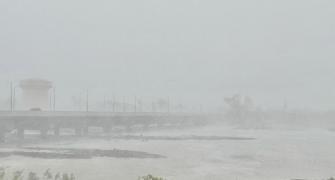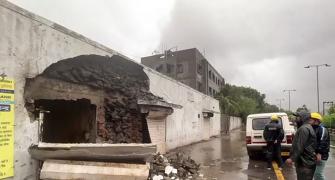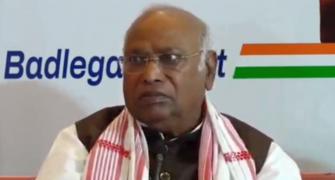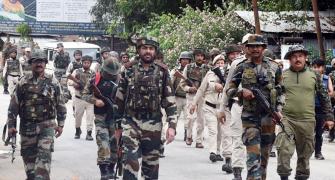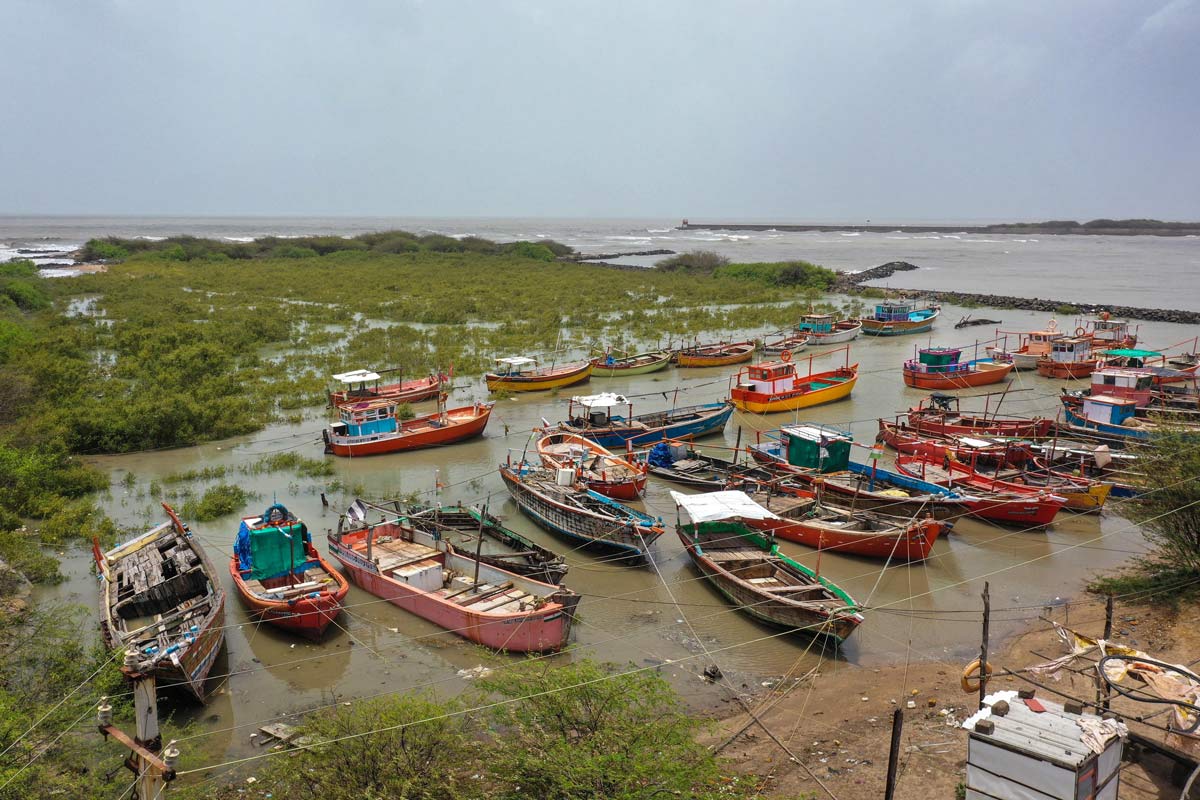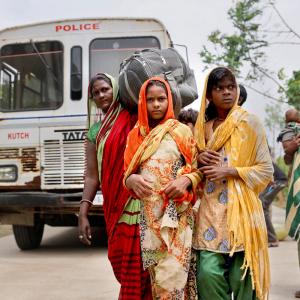No lives were lost after cyclone Biparjoy made landfall.
Preparations for Biparjoy were not only extensive, they were also telecast far and wide.
Ahead of the cyclone's landfall, Shyam G Menon observes there was considerable publicity on how much the government was geared up to face the storm and its aftermath.

It was the cyclone around the cyclone that missed our attention.
Britannica.com describes a cyclone as any large system of winds that circulates about a centre of low atmospheric pressure in a counter clockwise direction north of the Equator and in a clockwise direction to the south.
According to the Web site of the World Meteorological Organization (WMO), 'Over the past 50 years, 1,942 disasters have been attributed to tropical cyclones, which killed 779 324 people and caused US$1,407.6 billion in economic losses -- an average of 43 deaths and US$78 million in damages every day.'
Traditionally in India, cyclones have been a phenomenon associated with the Bay of Bengal. The Arabian Sea in comparison, brewed less cyclones.
That picture has been changing. Even as the Bay of Bengal remains the main theatre, the number of shows has been increasing in the Arabian Sea.
As per data compiled on Wikipedia, the 2023 cyclone season in the Northern Indian Ocean began early with a depression reported on January 30 and a Tropical Cyclone Formation Alert (TCFA) issued thereafter.
Over the next few days, courtesy its interaction with the land mass of Sri Lanka, the depression weakened and the TCFA was cancelled.
The next big one started taking shape on May 6. By May 11, it was a cyclonic storm christened Mocha and a day later, it transited through severe to very severe cyclonic storm.
On May 13, it reached peak intensity as a Category 5-equivalent cyclone. Luckily, it weakened a bit before landfall near Sittwe, Myanmar.
In anticipation of the cyclone, some 500,000 people were ordered to evacuate in Myanmar and Bangladesh.
In the storm's aftermath the Myanmar's state of Rakhine was declared a natural disaster area; overall damages in Myanmar were estimated at 1.5 billion dollars and the government of Myanmar estimated 463 people dead (ASEAN pegged it at a lower 145).
A day before, Mocha's genesis was noticed, the seeds of another system taking shape was reported from the Arabian Sea.
On June 6, after it intensified into a depression, a TCFA was issued.
It subsequently grew into a deep depression and a cyclonic storm with the name: Biparjoy.
It intensified into a severe and very severe cyclonic storm before weakening.
Then unexpectedly, it intensified into a Category 3-equivalent cyclone on June 11.
At its peak intensity it was an extremely severe cyclonic storm, Wikipedia's page on the event said.
With landfall forecast close to Jakhau in Kutch, India evacuated almost 100,000 people to safety in its state of Gujarat.
Post landfall, the death toll in the natural calamity was reportedly zero; news reports were more about fallen trees, damage to structures and villages without electricity.

Twenty five years earlier, on a June 1st, the beginnings of a depression were reported from around the same part of the Arabian Sea, where Biparjoy took birth.
It had a trajectory of growth that was similar too - strengthening, weakening and then intensifying.
On June 4, the first advisory was issued. It became a deep depression and a cyclonic storm and then, weakened.
Soon thereafter, it began to build up again. At its peak it was a very severe cyclonic storm with winds of 195 km/h.
On June 9, 1998, it made landfall near Porbandar in Gujarat. The storm had no fancy name like Biparjoy did.
The Joint Typhoon Warning Center called it 03A; the Indian Meteorological Department, ARB 02.
It, however, turned out to be one of the deadliest storms to hit the Gujarat coast.
The storm surge it brought in from the sea swept overland killing many.
An estimated 4,000-10,000 people lost their lives in the cyclone (source: Wikipedia).

One of the major reasons for the high death toll was poor communication.
When ARB 02 struck, India was just over three years old into mobile telephony.
The first mobile telephone call in the country was made from Kolkatta to Delhi on July 31, 1995; it was made by the then West Bengal chief minister Jyoti Basu to the then Union minister for communications, Sukh Ram.
The vast difference in scenario may be grasped from the fact that in 1998, in Kandla, among the most affected spots in Gujarat, general awareness of the severity of the approaching storm was limited.
Today, mobile phones, Internet and satellite TV spread information fast.
A November 2022 report in Mint, which quoted the secretary, ministry of information and broadcasting, said that India has over 1.2 billion mobile phone users, including 600 million with smart phones.
Better connectivity alone does not ensure reduced loss of life. A lot, it would seem, depends on how the information provided, is processed.

Twenty three years after the Gujarat Cyclone of 1998 (ARB 02), casualties were much less in Cyclone Tauktae of May 2021.
Happening in technologically more advanced times, it was the most powerful storm headed for Gujarat since the 1998 cyclone.
Of the 169 people estimated killed (all along its path in India; source: Wikipedia) in that first extremely severe cyclonic storm in the North Indian Ocean for the 2021 cyclone calendar, around 70 could be attributed to a single accident -- the sinking of a barge deployed for oil industry work, in the seas off Mumbai.
It can't be due to shortage of information. To that extent, the preparation for Biparjoy would appear to have paid dividends.
Early evening, June 16, 2023, Press Trust of India quoting the director general of the National Disaster Response Force said that while no lives had been lost post-landfall, prior to it, two people had died.

On a lighter note, around Biparjoy lay another cyclone, one that was distinctly different from nature's creation.
A cyclone is unlike an earthquake or a volcanic eruption. The former gives you no advance notice; the latter smokes and rumbles but an eruption may be anything from immediate, to weeks down the line.
With a cyclone, the media is assured extended interest. A script progressing to climax; ideal recipe for eyeballs-driven media.
Following the devastating train tragedy of June 2 (it killed 290 people and injured over 1,100), the outcry over railway safety that followed and the subsequent criticism about the nature of enquiry underway, a severe cyclonic storm wouldn't have been an instance the government wished to take lightly.
Preparations for Biparjoy were not only extensive, they were also telecast far and wide.
Ahead of the cyclone's landfall, there was considerable publicity on how much the government -- ranging from local authorities to police, rescue teams and the military -- was geared up to face the storm and its aftermath.
All of India, watched. Even the media, harassed and pushed around since the past several years, was served a surprise -- there was a communique requesting media personnel to stay safe while covering the cyclone.
For a country ranked 161 out of 180 in the 2023 World Press Freedom Index, the sudden concern for journalists must have startled.
Simply put, the media buzz around Biparjoy was stronger than for other storms in recent memory. Nobody can fault it.
To remember though is -- a cyclone plays out its natural destiny. But a media cyclone stays in human hands, its intensity and direction as managers wish it to be.
Around the same time as the Biparjoy-buzz played out, a political drama was unfolding in Tamil Nadu and in India's far east, the violence in Manipur continued.
Shyam G Menon, is a freelance journalist based in Mumbai.
Feature Presentation: Aslam Hunani/Rediff.com

